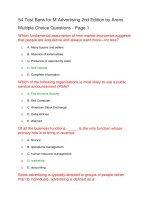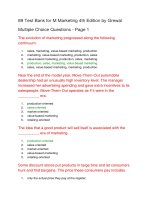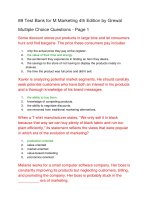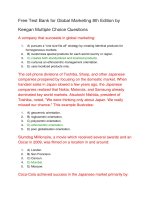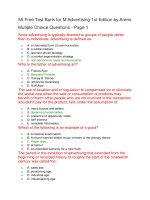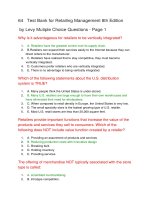Test bank for organic chemistry 8th edition by mcmurry
Bạn đang xem bản rút gọn của tài liệu. Xem và tải ngay bản đầy đủ của tài liệu tại đây (286.26 KB, 6 trang )
1 of 6
TEST BANK > CONTROL PANEL > POOL MANAGER > POOL CANVAS
Pool Canvas
Add, modify, and remove questions. Select a question type from the Add Question drop-down list and click Go to add questions. Use Creation Settings to establish
which default options, such as feedback and images, are available for question creation.
Add
Creation Settings
Name
Chapter 1--Structure and Bonding
Description
Modify
Instructions
Add Question Here
Essay
0 points
Modify
Remove
Question Give the ground-state electron configuration for carbon (atomic number 6).
2
Answer
1
2
1s 2s 2p 2p
x
1
y
2
2
2
or 1s 2s 2p
Add Question Here
Essay
0 points
Modify
Remove
Question Give the ground-state electron configuration for fluorine (atomic number 9).
Answer
2
2
2
2
1
2
2
5
1s 2s 2px 2py 2pz or 1s 2s 2p
Add Question Here
Essay
0 points
Modify
Remove
Question Give the ground-state electron configuration for magnesium (atomic number 12).
2
Answer
2
6
2
1s 2s 2p 3s
Add Question Here
Essay
0 points
Modify
Remove
Question How many electrons does silicon have in its valence shell?
Answer
four
Add Question Here
Essay
0 points
Modify
Remove
Question Exhibit 1-1
Write valid Lewis (electron-dot) structures for each formula below. Show all electrons as dots and show all non-bonding electrons.
C Cl
2
tetrachloroethylene
4
Answer
Add Question Here
Essay
0 points
Modify
Remove
Question Exhibit 1-1
Write valid Lewis (electron-dot) structures for each formula below. Show all electrons as dots and show all non-bonding electrons.
CO
2
carbon dioxide
Answer
Add Question Here
Essay
0 points
Modify
Remove
Question Exhibit 1-1
Write valid Lewis (electron-dot) structures for each formula below. Show all electrons as dots and show all non-bonding electrons.
CH O
4
methanol
Answer
Add Question Here
Essay
0 points
Modify
Remove
Question Exhibit 1-2
Consider the structure of urea, shown below, to answer the following question(s).
Refer to Exhibit 1-2. Fill in any non-bonding valence electrons that are missing from the line-bond structure.
Answer
Add Question Here
Essay
0 points
Modify
Remove
2 of 6
Question Exhibit 1-2
Consider the structure of urea, shown below, to answer the following question(s).
Refer to Exhibit 1-2. The carbon atom in urea is:
a. sp3 hybridized
b. sp2 hybridized
c. sp hybridized
d. not hybridized
Answer
b
Add Question Here
Essay
0 points
Modify
Remove
Question Exhibit 1-2
Consider the structure of urea, shown below, to answer the following question(s).
Refer to Exhibit 1-2. The predicted NH -C=O bond angle in urea is:
2
a.
b.
c.
d.
109.5°
120°
180°
not predictable
Answer
b
Add Question Here
Essay
0 points
Modify
Remove
Question Exhibit 1-3
Determine the hybridization for the indicated atoms in each structure below.
Refer to Exhibit 1-3. The hybridization of this oxygen atom (A) is ______.
Answer
2
sp
Add Question Here
Essay
0 points
Modify
Remove
Question Exhibit 1-3
Determine the hybridization for the indicated atoms in each structure below.
Refer to Exhibit 1-3. The hybridization of this oxygen atom (B) is ______.
Answer
3
sp
Add Question Here
Essay
0 points
Modify
Remove
Question Exhibit 1-3
Determine the hybridization for the indicated atoms in each structure below.
Refer to Exhibit 1-3. The hybridization of this carbon atom (C) is ______.
Answer
sp3
Add Question Here
Essay
0 points
Question Exhibit 1-3
Determine the hybridization for the indicated atoms in each structure below.
Refer to Exhibit 1-3. The hybridization of this carbon atom (D) is ______.
Modify
Remove
3 of 6
Answer
sp
Add Question Here
Essay
0 points
Modify
Remove
Question The molecular formula C H O can be converted into three-line bond (Kekulé) structures that are consistent with valence rules.
2 4
a.
a.
b.
b.
c.
d.
Which one of the Kekulé structures is not consistent with valence rules?
Explain why the structure you chose in part a is not consistent with valence rules.
Answer
a.
b.
d
The carbon bonded to the oxygen atom in structure d is pentavalent; it has 10 valence electrons. Carbon can only have eight
valence electrons. In addition, the other carbon has only six valence electrons when it would prefer to have eight.
Add Question Here
Essay
0 points
Modify
Remove
Question The original question was combined with #15. This placeholder question is here to maintain the integrity of the numbering system between
the printed copy and ExamView. Therefore, it has been marked "do not use on test" in ExamView's question information dialog. As a result, this
placeholder question is automatically prevented from being chosen as a test question.
Answer
Answer not provided.
Add Question Here
Essay
0 points
Modify
Remove
Question Convert the following structure to a skeletal drawing and give its molecular formula.
Answer
Molecular formula: C5H7Br
Add Question Here
Essay
0 points
Modify
Remove
Question Draw an orbital picture for acetylene, C H . Clearly label each bond type and indicate the type of orbitals involved in each bond.
2 2
Answer
Add Question Here
Essay
0 points
Modify
Remove
Question Exhibit 1-4
Propose possible structures for a molecule that meets each of the following descriptions.
3
Refer to Exhibit 1-4. Contains two sp hybridized carbons and two sp hybridized carbons.
Answer
Add Question Here
Essay
0 points
Modify
Remove
Question Exhibit 1-4
Propose possible structures for a molecule that meets each of the following descriptions.
3
2
Refer to Exhibit 1-4. Contains one sp hybridized carbon and two sp hybridized carbons.
Answer
Add Question Here
Essay
0 points
Modify
Remove
4 of 6
Question Convert the following molecular model into a condensed structure and a skeletal structure.
Answer
Add Question Here
Essay
0 points
Modify
Remove
Question Convert the following molecular model into a condensed structure and a skeletal structure.
Answer
Add Question Here
Essay
0 points
Modify
Remove
Question Convert the following molecular model into a condensed structure and a skeletal structure.
Answer
or more specifically;
Add Question Here
Essay
0 points
Modify
Remove
Question Indicate the hybridization on each of the carbon atoms indicated with a number in the molecular model shown.
Answer
3
Carbon 1: sp
2
Carbon 2: sp
Add Question Here
Essay
0 points
Modify
Remove
Question Draw the orbital diagram showing the ground-state electron configuration of sulfur.
Answer
Add Question Here
5 of 6
Essay
0 points
Modify
Remove
Question Fill in any nonbonding valence electrons that are missing from the following structural representation of the amino acid cysteine.
Answer
Add Question Here
Essay
0 points
Modify
Remove
Question There are two substances with the molecular formula C H N. Draw them and describe how they differ.
2 7
Answer
The two structures differ in the number of hydrogen atoms and carbon atoms bonded to the nitrogen atom. The first structure contains the
carbon atoms bonded in a two carbon chain while in the second structure the two carbons atoms are isolated from each other by the
nitrogen atom.
Add Question Here
Multiple Choice
0 points
Modify
Remove
Question Overlap of the two atomic orbitals shown could result in a:
Answer
s bond
s or p depending on the direction of the overlap.
pbond
Add Question Here
Multiple Choice
0 points
Modify
Remove
Question Hybridization of the atomic orbitals shown would result in:
Answer
sp hybridization
3
sp hybridization
2
sp hybridization
Add Question Here
Multiple Choice
0 points
Question Which of the following represents a hybrid orbital?
Answer
Modify
Remove
6 of 6
Add Question Here
Multiple Choice
0 points
Modify
Remove
Question What type of hybridization is exhibited by carbon in the following substance?:
Answer
sp hybridization
sp2 hybridization
3
sp hybridization
Add Question Here
Multiple Choice
0 points
Modify
Remove
Question What type of hybridization is exhibited by carbon in the following substance?:
Answer
sp3 hybridization
sp hybridization
2
sp hybridization
Add Question Here
Multiple Choice
0 points
Modify
Remove
Question What type of hybridization is exhibited by the nitrogen atom in the following substance and how many lone pairs are present on the
nitrogen?:
Answer
sp hybridization and 2 lone pairs
3
sp hybridization and 1 lone pair
3
sp hybridization and 2 lone pairs
2
sp hybridization and l lone pair
sp hybridization and 1 lone pair
2
sp hybridization and 2 lone pairs
Add Question Here
Multiple Choice
0 points
Modify
Remove
Question If all the missing bonds in the following structure are sigma bonds to hydrogen atoms, how many hydrogen atoms are missing from this
structure? Atoms other than carbon are labeled.
Answer
7
10
12
14
None of these is the correct number.
Add Question Here
